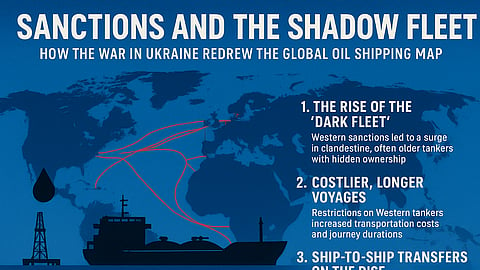Sanctions and the Shadow Fleet: How the War in Ukraine is Redrawing the Global Oil Shipping Map
The Ukraine war has not only reshaped geopolitics—it has rewritten the logistics of global oil trade. Western sanctions on Russian crude have forced a seismic shift in how oil travels the seas, ushering in a new era of shadow fleets, re-routed passages, and rising maritime risks.
The Rise of the “Dark Fleet”
When Western insurers and maritime firms pulled out of Russian-linked trade, hundreds of aging, loosely regulated tankers stepped in to fill the void.
How Smart Containers are Optimising Multimodal Transport Across Supply Chains
This so-called shadow fleet—often flagged in nations with minimal oversight—now moves millions of barrels daily under the radar, masking origins and ownership to dodge sanctions.
Costlier, Longer Voyages
Sanctions have upended traditional routes. The once-efficient trans-Atlantic trips that took five to six days now stretch over two weeks as tankers avoid restricted ports and insurance-linked regions. The result: freight rates have spiked, adding a new inflationary layer to global energy prices.
Ship-to-Ship Transfers on the Rise
To conceal cargo origins, Russian crude is often transferred between ships mid-ocean—sometimes multiple times—especially in the Baltic and Mediterranean. These “dark transfers” make oil tracking nearly impossible, heightening the risk of spills and collisions.
Global Tanker Shortage
About one-fifth of the world’s tanker fleet is now absorbed by Russian trade. This squeeze on available ships has raised global charter rates and strained supply chains elsewhere—from the Persian Gulf to West Africa.
Arctic Detours via the Northern Sea Route
Facing risks in the Black Sea, Moscow increasingly relies on the Northern Sea Route (NSR)—an icy shortcut along Russia’s Arctic coast—to export oil to Asia. Ice-class vessels now push through this frigid corridor, backed by state infrastructure investments, signaling a long-term strategic shift.
Mounting Safety and Environmental Concerns
The shadow fleet’s average vessel age exceeds 20 years, with limited maintenance and subpar safety records. Several incidents—like the Eagle S damaging undersea cables in the Baltic—highlight growing environmental and infrastructural dangers.
Cracks in Insurance and Oversight
Most shadow tankers lack legitimate coverage from P&I Clubs or classification by recognized authorities. Without credible insurance, accountability for accidents or spills remains murky—a ticking time bomb for coastal nations and global insurers.
Rising Enforcement and Legal Scrutiny
Countries like Germany and Denmark have begun questioning tankers in their waters about insurance and registration. Meanwhile, the EU and UK have tightened oil price caps—from $60 to $47.60 per barrel—while the US prepares new sanctions targeting opaque ownership networks.
The Ripple Effect
Western sanctions may have choked Russia’s official oil trade, but they have also fragmented the maritime energy ecosystem. Today’s tanker map is more expensive, risky, and obscure than ever.
As nations fortify enforcement and the Arctic corridor grows in relevance, the world’s shipping lanes are entering a new, uncertain era—where geopolitics, not efficiency, decides the flow of energy.
Read More: MSC Rolls Out Three New Major Shipping Services to Expand Global Connectivity


